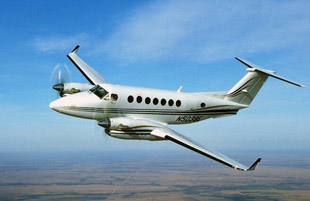 Beechcraft’s largest iteration of the King Air family, the 350, was certified in 1989 and first appeared as a 1990 model. The 350—and the 300 before it—is certified under the FAA’s Part 23 Commuter category since both weigh more than 12,500 pounds. Because of that weight, the 300 and 350 are the only King Airs that require a type rating of its pilots. The Commuter category certification assures that the 350 has single-engine safety margins identical to those of a jet certified to Part 25 standards.
Beechcraft’s largest iteration of the King Air family, the 350, was certified in 1989 and first appeared as a 1990 model. The 350—and the 300 before it—is certified under the FAA’s Part 23 Commuter category since both weigh more than 12,500 pounds. Because of that weight, the 300 and 350 are the only King Airs that require a type rating of its pilots. The Commuter category certification assures that the 350 has single-engine safety margins identical to those of a jet certified to Part 25 standards.
With a 300-knot cruise speed, the King Air 350 competes well against jets on trips shorter than 400 nautical miles, for example. In such a race, the 350 will arrive only about 15 minutes later than competitive jets while carrying a bigger load and using much less fuel. And unlike jets, the King Air and other turboprops are basically recession proof because of their proven efficiency. While many companies dump their jets when fuel prices spike, turboprops rise in value.
Another hallmark of the King Air 350 is its ability to haul big loads out of short runways when compared to a jet. This makes the 350 a valuable asset to a regional corporation or state government, for example. It shines on multi-leg short hops to medium-sized (4,000-foot runway) or larger airports. Because of its massive useful load and equally large fuel capacity, pilots often fuel the airplane in the morning and fly multiple legs throughout a day on a single load, which can be advantageous if you get a decent fuel price at your home base.
On longer trips, the King Air 350 can vault as high as FL350 where, at a long-range-cruise power setting, speeds are in the 230- to 240-KTAS range while burning a miserly 360 pounds (54 gals) per hour. In go-fast mode, the 350 can do 310 KTAS on 773 pounds (115 gals) per hour at FL240. Owners have a very wide speed/efficiency margin to work with in the 350, unlike the jets—which must fly high to achieve efficiency.
Unlike jets, however, the King Air 350 lacks fully integrated systems in its avionics suite. Systems dating back to the King Air’s 1964 roots cohabitate with modern avionics in the new 350i. It also lacks FADEC engine control like modern jets. There are many versions of 350 available: air ambulance, reconnaissance, freighter, and the new 350iER extended-range model. The 2009 Model 350i introduced factory installation of Raisbeck wing lockers to enhance the baggage-carrying volume. Older 350s have only a rear-cabin baggage compartment.
According to Vref, average values for the King Air 350 range from $1.5 million for a 1990 model to $7.5 million for a 2014 model.
While a turboprop never has the sex appeal of a jet, there’s no denying the impressive speed/efficiency flexibility found in the King Air 350. Add to that the no-compromises ability of the 350 to carry a huge load out of short runways, and it is a worthy competitor to jets.
Pete Bedell is a pilot for a major airline and co-owner of a Cessna 172 and Beechcraft Baron D55.


